Zheng Bijian is chairman of the China Institute for Innovation and Development Strategy and a member of the Berggruen Institute’s 21st Century Council. This article is adapted from remarks he presented at the Belt and Road summit recently held in Beijing.
BEIJING ― A strong anti-globalization wave in the form of trade protectionism and populism has swept parts of the developed world, calling the future of economic globalization into question. In this context, the Belt and Road Forum for International Cooperation in Beijing came at a most critical and opportune time. It inaugurates the next phase of globalization that promises a new foundation for shared global growth.
There are three key points to grasp in understanding the historical significance of this Chinese initiative.
First, the problems of economic globalization do not portend the end of globalization or throw it into reverse gear. Rather, these problems signal that the current round of economic globalization, after four decades of development, is ready for a major historical turning point.
Over the 40 years since the present round of economic globalization started in 1970s, we have enjoyed both great economic achievements and, at the same time, witnessed a lot of problems piling up. That is the “dual nature” of economic globalization. The door was thrown wide open for financial speculation that damages the real economy. The hollowing out of domestic manufacturing industries has exacerbated unemployment in the developed world. This has led to increased social polarization and caused a sharp rise of populism. All these problems have now come to a boil in some developed countries, further affecting the rest of the world.
There are two alternatives before us in facing these challenges. One is to resort to trade protectionism and the other is to guide globalization into a new phase in the spirit of a “community of common destiny for all mankind” through a more balanced distribution of existing and innovative forces of wealth production. That can be done by establishing a new balance between financial capital and the real economy, by the optimization of global governance and the systemic reform of world economic and political order.
Protectionism will only lead the world backwards to where it was before economic globalization started and therefore is clearly not a desirable option. Embracing the challenges of globalization and fixing them is the right choice because it will enhance the prospect of shared prosperity instead of falling back into a fragmented world.
Embracing the challenges of globalization and fixing them will enhance the prospect of shared prosperity instead of falling back into a fragmented world.
 Bloomberg via Getty Images
Bloomberg via Getty ImagesSecond, the shift of world economic gravity to the emerging nations made possible through the last few decades of economic development has laid the historical foundation for the vision of the Belt and Road Initiative to take hold. Infrastructure and other investments will help the developing world to further thrive.
Given the advances in the developing world, it is not surprising that in the nearly four years since the Belt and Road Initiative was first proposed, it has received a positive response and support from more than 100 countries and international organizations. While economic globalization has brought problems in the developed economies to a head on the one hand, it has also paved the way for developing economies to rise as a whole on the other.
According to the latest projections of the IMF, the world economy is expected to grow at 3.6 percent from 2017 to 2018, higher than the 3.2 percent in the past two years, which is obviously good news. A closer look at the data shows that developing economies are expected to grow faster at 4.6 percent, more than double that of the developed economies at 2 percent. And if we put it in historical perspective, it is even more revealing. In terms of purchasing power parity, the size of developed economies as a whole versus that of the developing economies as a whole was at a ratio of 64:36 in 1980 and 50:50 in 2007. In 2018, this ratio is expected to reverse to 41:59, tipping the scales toward the developing world.
If this trend can be sustained, it means that the global economy as a whole, driven by the developing world, will continue to gather new momentum for growth in the second, third and fourth decades of this century. The more rapid growth in the developing economies will in turn stimulate renewed growth in the developed world by becoming an even larger market for its goods and services. The new phase of globalization will thus be a reverse from the past in which the developed world was the growth engine.
Seen in this light, the Belt and Road Initiative is really a response to the historical demand to shift economic globalization to a new level by leveraging the benefits of the first phase of globalization to generate new momentums over the decades ahead.
The new phase of globalization will be a reverse of the past in which the developed world was the growth engine.
Third, the Belt and Road Initiative will go down in history as the turning point from marine-based globalization to comprehensive globalization, integrating the inland and marine economies.
Each previous round of economic globalization was marine–based, spreading from the Atlantic to the Pacific. This time it is different. The vast inland economies once left behind will now become part of economic globalization. By connecting container cargo transportation, expressways, high speed trains, air transportation, the internet, modern online financial products and other instruments old and new, the Belt and Road plan will fully integrate marine and inland economies. Connecting these two spheres will induce the overall economic rise of the eastern, central and western regions of China. It will spur economic cooperation and development across the Eurasian continent, further reaching Africa. Even the Americas will be touched. This is the most prominent new feature of the new phase of economic globalization.
When the Belt and Road Initiative was first proposed, it was met with skepticism, regarded as China’s way to transfer its excess production capacity abroad or as China’s Marshall Plan to bring others into its sphere of influence. Some claimed it was merely a new form of neocolonialism or a contrivance aimed against the Western countries. Such attitudes stem from the narrow mindset of a zero-sum game that fails to understand that the Belt and Road Initiative is, in essence, about cooperation. It is about building upon converging interests and fostering communities of interests ― and ultimately, a global community of common destiny. In short, it is a strategic vision of “cooperative development” consonant with the imperative that economic globalization move into a new stage.
 Xinhua
XinhuaNeedless to say, China is fully aware that the Belt and Road Initiative, as a collaborative effort by many countries, is not an easy task that can be accomplished overnight. We need to make long-term commitments. To make it work for all, the countries involved must work together and be prepared to work together for the long term.
In sum, international cooperation under the Belt and Road Initiative will become a strong driver and important symbol of the new phase of economic globalization. It promises to transform the world over coming decades no less than the first phase transformed the world over previous decades.



